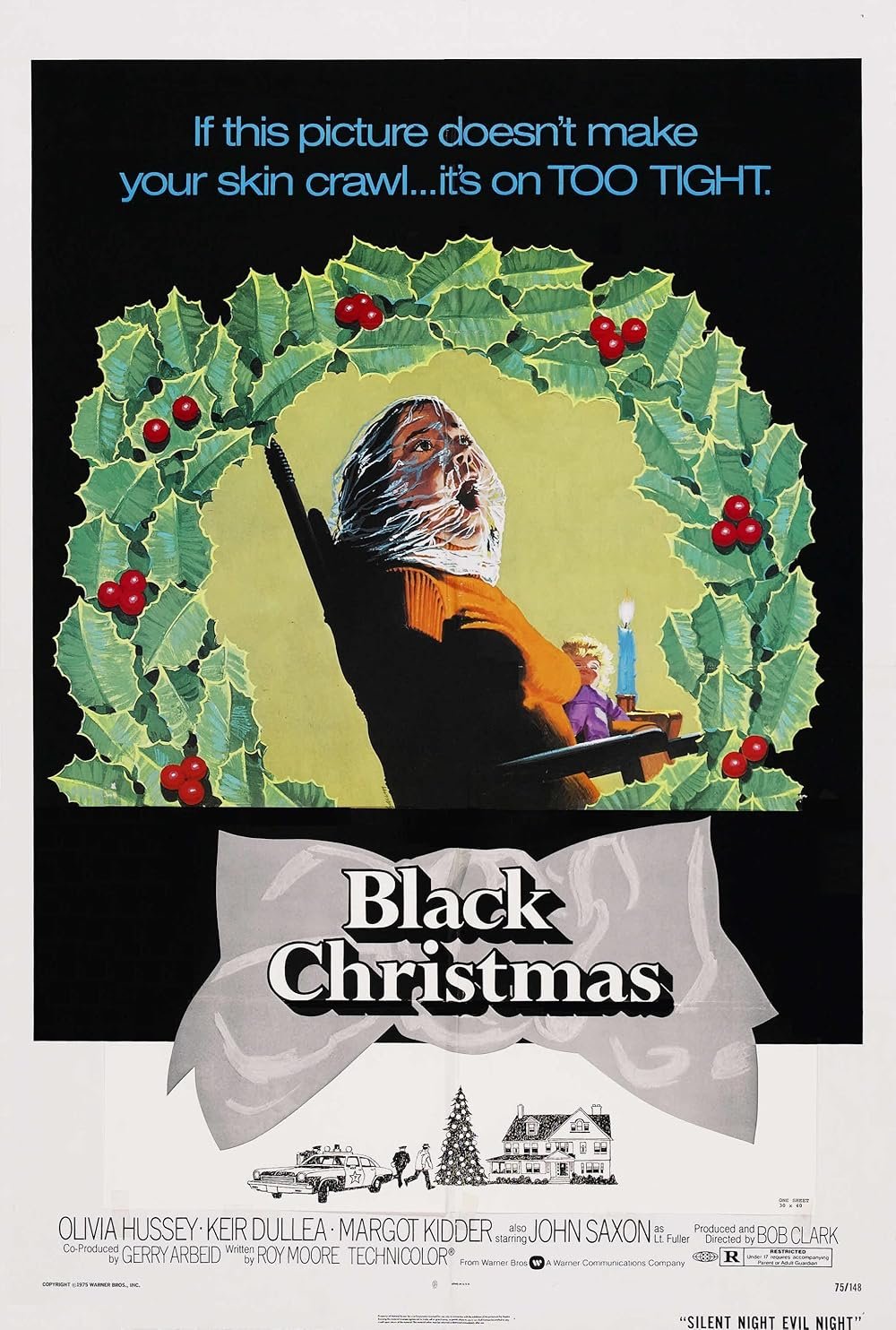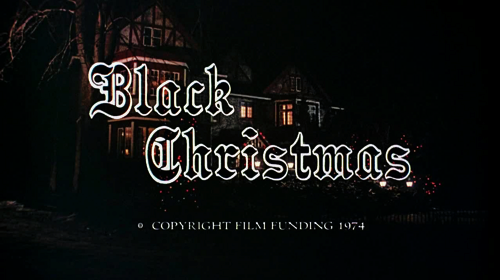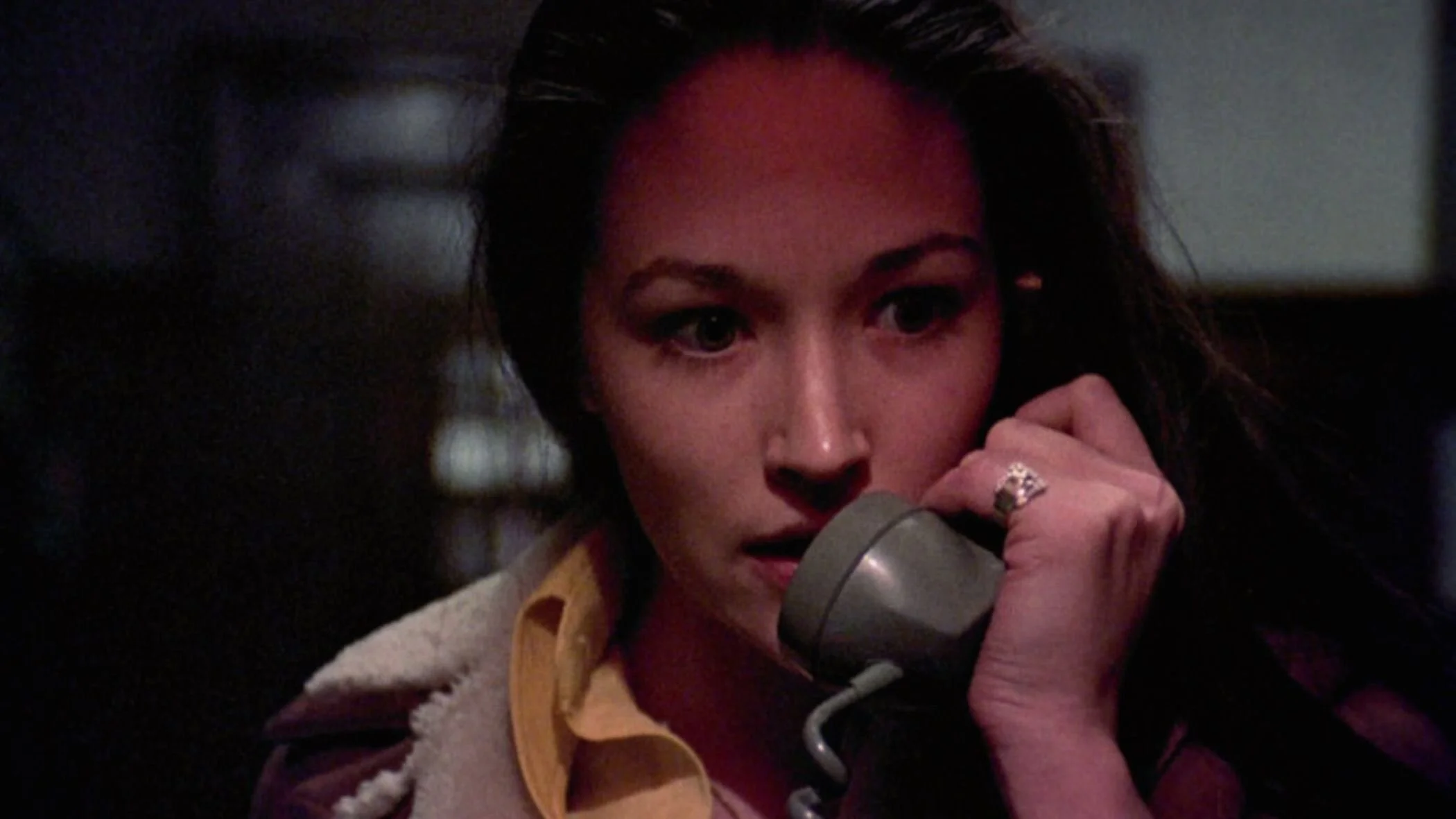It’s Beginning to Look A Lot Like Christmas
Cinematic Semicentennial Series – 1974 Edition
As promised, we are going to dedicate this edition of Concentric Cinema to a much-beloved holiday film, one that brings people together every December without fail. Yes, we are referring to the revered Bob Clark classic A Christmas Story Black Christmas.
Considering the season, it seemed apropos to kick off our Cinematic Semicentennial Series with one of the early and most cherished films in the holiday horror subgenre. The film was released in Canada on October 11, 1974, and in the U.S. on December 20, 1974.
You might ask why in the name of all that is merry and bright would you want to set a horror story during a season meant to elicit warm and fuzzy feelings and engender good will towards humanity. Well, I have some thoughts about that but that’s a question for another day. And there will be other days; holiday horror boasts quite a few titles under its festive banner.
Party Crasher
Our film opens with a gentle rendition of Silent Night playing over a gothic-lettered title screen. We look onto a large three-story Tudor revival home on a chilly December night; the trees in front are strung with large colored Christmas lights and we glimpse people chatting behind decorated windows with a fire roaring in the background. We learn that this is a sorority house (Pi Kappa Sigma) and its residents are throwing a small Christmas party before they all depart for the holiday break.
As the festivities continue inside, a mysterious dark-silhouetted stranger approaches the front of the house. We quickly cut to the stranger’s POV via a slightly disorienting wide-angle lens. He makes his way to the side of the house, climbs up the trellis, and enters through the third-floor attic window. He pokes around the attic, which is full of assorted dusty furniture, cobwebs, boxes, and knick-knacks. The stranger then stealthily creeps down to the third-floor landing to spy on the sorority sisters from above.
The Women of Pi Kappa Sigma
Our story focuses on a handful of women in this sorority. Their characters are rounded out through clever bits of dialogue and nonverbal cues, where we also learn more about their social dynamics. There is the profane and irreverent Barb (Margot Kidder), a heavy drinker who is quick to crack jokes and rustle feathers; Phyl (Andrea Martin), a kind and affable young woman who exudes a maturity beyond her college-aged years; and Clare (Lynne Griffin), a shy and reserved member of the sorority who often butts heads with Barb.
And then we have Jess: our strong, levelheaded heroine played by the great Olivia Hussey. Jess is thoughtful, loyal, and compassionate, and her grounded personality positions her in stark contrast to our impulsive Barb. Jess’s boyfriend Peter, an aspiring classical pianist, is emotionally unbalanced and immature. When Jess informs him that she is pregnant and intends to have an abortion, he responds with self-righteous anger and arrogant pronouncements. Peter will continue to spiral as the film unfolds.
Mrs. Mack (Marian Waldman), the House Mother of Pi Kappa Sigma, lends some campy comic relief to the proceedings. Mrs. Mack seems to have a pretty good relationship with the sorority sisters but speaks resentfully of having to be the caretaker of their morality and having to negotiate disapproving parents. She curses and complains under her breath and self medicates with booze that she stashes all around the house.
“Agnes, it’s me Billy”
The phone rings. Jess takes the call and announces to her sisters that it’s “the moaner,” signaling to the viewer that this is a repeat offender. The girls listen in as the caller unleashes a series of vulgarities and explicit suggestions that fit the standard obscene phone call template—with one major caveat: he uses multiple voices infused with a kind of manic, unhinged energy that is nothing short of unsettling.
We find out rather quickly that the phone call was coming from our intruder, who is dialing in from a separate line inside the house. We also come to learn that the intruder’s name is Billy, or so he refers to himself in future calls. On each of the subsequent calls Billy seems to be manifesting different people and/or personalities, including what we suspect are his younger sister Agnes and his parents. The viewer tries to glean and piece together Billy’s background story through his deranged rants, but suffice to say he is anything but a reliable source.
Pi Kappa Sigma enduring Billy’s call.
It isn’t long before Billy claims his first victim. Without getting into too much detail, one of the sorority sisters is murdered upstairs while the others are enjoying their festivities. The killer positions her body in a rocking chair in the third-floor attic window; she is on clear display—eyes open wide, mouth agape, and head tightly wrapped in plastic. This is perhaps the most ubiquitous (and unsettling) shot of the film, used in many advertisements and posters.
After several reports from the girls, the police begin an investigation led by Lt. Fuller, played by the late (and great) character actor John Saxon. Local law enforcement has their hands full between the obscene calls and two missing persons: a local 13-year-old girl and the (unbeknownst to everyone else) murdered sorority sister. The tension and threat only rise from here on as our killer is emboldened to continue targeting the women in the house despite the police’s attempts to trace the source of the increasingly disturbing calls.
My two cents
Black Christmas excels is in establishing a dark, cold, and menacing tone that pervades every single aspect of the film. The premise alone is chilling enough: an extremely dangerous individual is occupying a safe space unbeknownst to its inhabitants. The viewer knows where Billy is and what he is doing much of the time, while the main characters remain completely unaware. This generates a different kind of anxiety for the audience.
Apparently, Bob Clark was partly inspired by the urban legend of the “babysitter and the man upstairs” based on some real-life stories that do not much resemble Black Christmas (check out the supplements at the end of this feature to learn more). There is a very small subgenre of these types of film, the most famous of which is 1979’s When a Stranger Calls starring Carol Kane, a well-made thriller worth viewing.
There is a consistent theme of violation of safe spaces in Black Christmas. Not only are our female protagonists deprived of a safe space physically with a maniac hiding in their midst, but they are also denied a safe psychological space. Jess is repeatedly exposed to Billy’s perversions, madness, and rage. She isn’t granted the space to process her pregnancy and decision to terminate it in part because she is continually bombarded by Billy’s psychotic ravings. Barb is equally violated by these obscene phone calls and ultimately we see several physical violations as Billy commits his murders. On a separate note, we are also confronted with the violation of the warmth and good tidings of the holiday season.
Jess takes a break to enjoy some carolers
Billy’s calls are perhaps the most disturbing piece of this film. Often with Jess on the receiving end, they include a twisted combination of wailing, screeching, scolding, crying, cackling, pleading, and threats. The calls offer potential clues to Billy’s backstory, capture the fantastic ravings of a deeply disturbed person, or present us with a bit of both. What we can say for certain is that Billy’s vocal gymnastics are profoundly unsettling, as he seamlessly transitions from one persona to another. These characters include a crying toddler, an older child, and reprimanding adults—it’s all very grotesque. If we can suss out anything from these calls it’s that Billy may have hurt Agnes when she was a child. But again, we speculate. Voicing Billy was a twisted achievement in its own right. It took three actors to create this character, including Nick Mancuso, director Bob Clark himself, and another actress whose name remains unknown to me. Apparently, Mancuso delivered some of Billy’s dialogue standing on his head, helping to strain and distort his voice. I would say it worked.
We never quite get a good look at Billy aside from an arm here or a leg there; in one particularly frightening scene, we are presented with a shot of his eye peering through a small crack in a doorway. These small, partial, and disembodied glimpses at our killer work very well in highlighting his fractured and disjointed psyche.
Props to the cinematography, production design, and score for reinforcing the film’s cold, dark tone so effectively. From the interiors of the house to the exteriors, the film captures so many levels of black through shadows, set design, and lighting. The effect is all-encompassing and we feel almost immersed in the many shades and layers of black. The score complements the film’s dark themes extremely well, adding some heavy, piercing, and almost violent chords at just the right moments. Composer Carl Zittrer explains that he achieved these sounds by scraping household items like combs, brushes, and forks over the keys of an old, untuned upright piano. He essentially destroyed the instrument (a horror of another kind) but at least it was in service to the film.
The Black Christmas cast is one of the reasons the film works so well. Jess, Barb, and Phyl are not flat, generic characters—they feel very grounded and real. That can be attributed to Roy Moore’s sharp screenplay, but perhaps especially the performances of Margot Kidder, Olivia Hussey, and Andrea Martin. The three actors have an easy chemistry that just feels natural. Keir Dullea, perhaps best known for playing Dr. Dave Bowman in 2001: A Space Odyssey (1968), is both intense and unsettling as Peter, and John Saxon can always be relied on to deliver a strong performance in many a genre film.
Lobby cards
Black Christmas at 50
While Black Christmas is not the first ever holiday horror film, it is probably one of the first to set a new standard for yuletide shockers. I understand that there are individuals and whole families who watch this film every holiday season. Can one get cozy and watch a movie like Black Christmas? As incongruous as that seems, the answer—for some at least—is yes. While Bob Clark was a talented director with an eclectic filmography, I could see how some may have difficulty reconciling his two Christmas classics. And while Black Christmas and A Christmas Story may have the holiday in common and seemingly little else, in watching both you can sense that the two films share a similar look. It turns out cinematographer Reginald Morris worked on both films.
Black Christmas It is also a seminal film in the soon-to-be-burgeoning slasher subgenre, which would explode in the late 1970s and early 1980s. It helped set some of the iconic tropes of the genre, such as stalking and the killer’s POV. By the early 1980s, slashers and films where babysitters, high schoolers, campers, and sorority sisters are terrorized by a psychopathic killer had evolved from a common trope to a cliché. But in back in 1974 it was a relatively new concept.
As mentioned earlier, the subject of abortion informs one of the film’s plot points. The landmark Supreme Court Roe v. Wade decision took place in 1973, one year before Black Christmas was released. This topic feels more prescient than ever as our current Supreme Court overturned Roe v. Wade in the summer of 2022. As the fight for women’s health and reproductive rights continues, we are reminded that progress is hardly ever linear. For more on this topic, I recommend a piece (linked in the supplements) which explores abortion and toxic masculinity, another important theme in Black Christmas.
This may seem like an aside, but I find this story fascinating as it relates to two of the most revered holiday horrors of all time: Clark’s Black Christmas and John Carpenter’s Halloween. According to Clark, the two filmmakers were discussing horror film projects when Carpenter asked him if he intended to do a sequel to Black Christmas. Clark said no, but with some prompting from Carpenter added that if he did, he would have the killer caught and institutionalized, eventually making his escape and returning to the sorority house the following fall; the film would be titled Halloween. Clark made it very clear that while Black Christmas may have provided some inspiration for his fellow filmmaker’s horror classic, Halloween was very much John Carpenter’s creation.
I am going to wrap up this Christmas gift by saying I love this film with all of my (cold, black) heart. It strikes the perfect balance between holiday nostalgia (at least on an aesthetic level) and chilling horror. And for the record, I do have great affection for A Christmas Story and the more recent sequel A Christmas Story Christmas, released in 2022; both can serve as good chasers after knocking back a shot of Black Christmas.
Cast (abridged)
Olivia Hussey – Jess Bradford
Margot Kidder – Barb
Andrea Martin – Phyl
John Saxon – Lt. Ken Fuller
Marian Waldman – Mrs. Mack
James Edmond – Mr. Harrison
Keir Dullea – Peter
Art Hindle – Chris
Crew (abridged)
Director – Bob Clark
Writer – Roy Moore
Music – Carl Zittrer
Production Design – Karen Bromley
Cinematography – Reginald H. Morris
How did I watch?
Shout Factory Blu ray
Also currently streaming on Peacock
Running Time: 1h 38m
Rating: R
Did you know?
Canadian-born Margot Kidder, who left us in 2018, has some additional horror/thriller credentials, having starred in Sisters (1972) and The Amityville Horror (1979). She is best known, however, for playing Lois Lane in Superman: The Movie (1978) and Superman II (1980).
Bob Clark has confirmed in an interview that Billy and Agnes are indeed brother and sister.
Olivia Hussey, famous for her turn at Juliet in Franco Zeffirelli’s Romeo Juliet (1968), has also dabbled in genre films like the trashy but fun Australian exploitation movie Turkey Shoot (1982) and the epic (at the time) made-for-TV adaptation of Stephen King’s IT (1990).
John Saxon has major genre credentials including Queen of Blood (1966), Enter the Dragon (1973), Tenebrae (1982), and Nightmare on Elm Street (1984). My father was boyhood friends with Saxon back in Brooklyn, a fact he would often mention when we’d spot him on TV. I wish I had asked him more about this friendship, but alas I was a kid at the time and not as interested in actor trivia.
There have been a couple of remakes/reimaginings of Black Christmas since the original’s release, one in 2006 and the other in 2019. I haven’t seen either though I am sure I’ll get to them eventually. Fun fact: Andrea Martin plays Mrs. Mack in the 2006 remake.
Gilda Radner was signed on to play Phyl but had to drop out a month before filming started as she landed a gig on a new late-night comedy show known as Saturday Night Live.
Olivia Hussey has recounted the story of meeting Steve Martin, who told her that she was in one of his favorite films. She assumed he was referring to Romeo & Juliet, but Martin clarified that it was, in fact, Black Christmas, which he had seen 23 times.
Recommendations based on Black Christmas
Halloween (1978)
When A Strangers Calls (1979)
My Bloody Valentine (1981)
The are many, many more slashers and holiday horror movies we could mention here but let’s save those for later.
Supplements
The Chilling Real-Life Murders That Inspired Black Christmas (Slashfilm.com)
How ‘Halloween’ Was Basically an Unofficial ‘Black Christmas’ Sequel (Bloody Disgusting.com)
50 Years Later, ‘Black Christmas’ (1974) Is Just as Relevant and Frustrating as Ever (Horrorpress.com)
Up Next— we continue our Cinematic Semicentennial Series with a film that delves into the murky world of surveillance.












